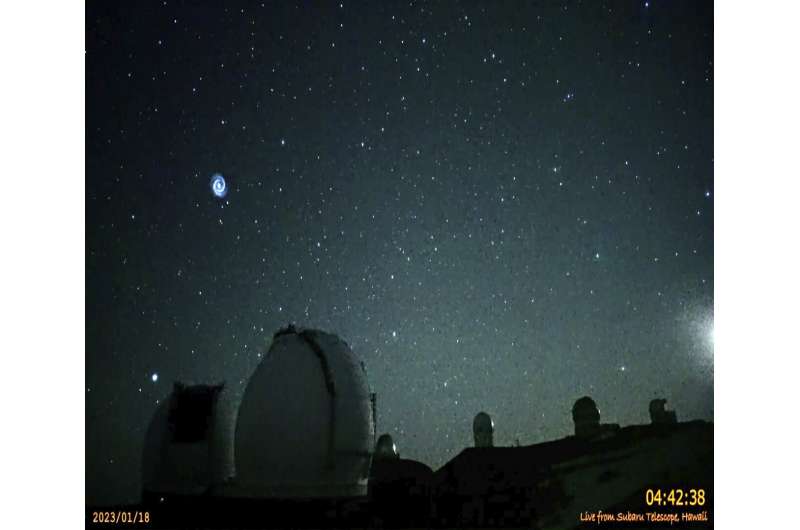This article has been reviewed according to Science X's editorial process and policies. Editors have highlighted the following attributes while ensuring the content's credibility:
fact-checked
reputable news agency
proofread
Camera captures night sky spiral after SpaceX rocket launch

A camera atop Hawaii's tallest mountain has captured what looks like a spiral swirling through the night sky.
Researchers believe it was from the launch of a military GPS satellite that lifted off earlier on a SpaceX rocket in Florida.
The images were captured on Jan. 18 by a camera at the summit of Mauna Kea outside the National Astronomical Observatory of Japan's Subaru telescope.
A time-lapse video shows a white orb spreading out and forming a spiral as it moves across the sky. It then fades and disappears.
Ichi Tanaka, a researcher at the Subaru telescope, said he was doing other work that night and didn't immediately see it. Then a stargazer watching the camera's livestream on YouTube sent him a screenshot of the spiral using an online messaging platform.
"When I opened Slack, that is what I saw and it was a jaw-dropping event for me," Tanaka said.
He saw a similar spiral last April, also after a SpaceX launch, but that one was larger and more faint.
SpaceX launched a military satellite the morning of Jan. 18 from Florida's Cape Canaveral Space Force Station.
The location of the spiral matched where the second stage of the SpaceX rocket was expected to be after its launch.
SpaceX didn't respond to an email sent Friday seeking comment.
Tanaka said the observatory installed the camera to monitor the surroundings outside the Subaru telescope and to share Mauna Kea's clear skies with the people of Hawaii and the world.
Someone watching the sky in less clear conditions, for example from Tokyo, might not have seen the spiral, he said.
The livestream is jointly operated with the Asahi Shimbun, a major Japanese newspaper, and frequently gets hundreds of viewers. Some tune in to watch meteors streak across the sky.
The summit of Mauna Kea has some of best viewing conditions on Earth for astronomy, making it a favored spot for the world's most advanced observatories. The summit is also considered sacred by many Native Hawaiians who view it as a place where the gods dwell.
© 2023 The Associated Press. All rights reserved. This material may not be published, broadcast, rewritten or redistributed without permission.




















